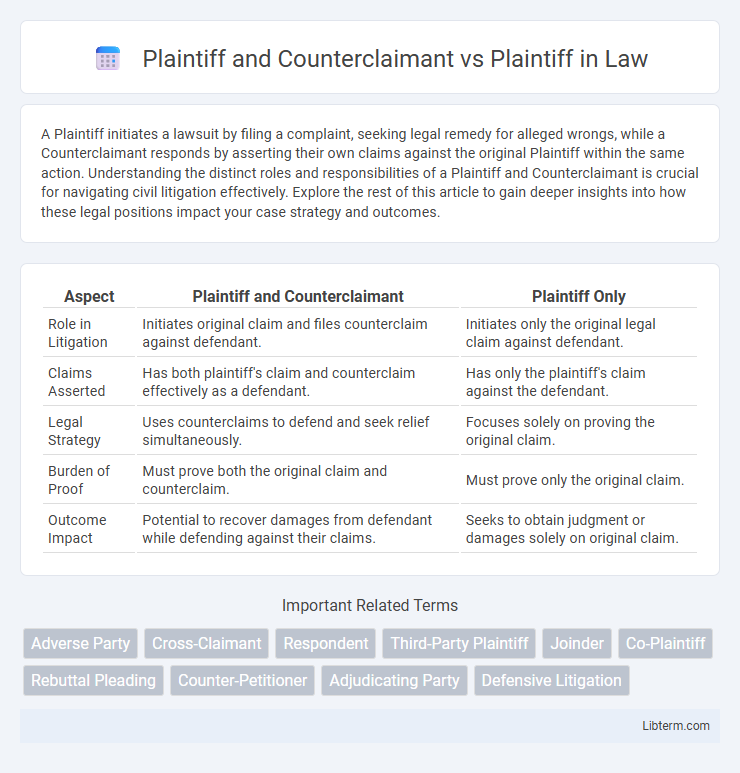A Plaintiff initiates a lawsuit by filing a complaint, seeking legal remedy for alleged wrongs, while a Counterclaimant responds by asserting their own claims against the original Plaintiff within the same action. Understanding the distinct roles and responsibilities of a Plaintiff and Counterclaimant is crucial for navigating civil litigation effectively. Explore the rest of this article to gain deeper insights into how these legal positions impact your case strategy and outcomes.
Table of Comparison
| Aspect | Plaintiff and Counterclaimant | Plaintiff Only |
|---|---|---|
| Role in Litigation | Initiates original claim and files counterclaim against defendant. | Initiates only the original legal claim against defendant. |
| Claims Asserted | Has both plaintiff's claim and counterclaim effectively as a defendant. | Has only the plaintiff's claim against the defendant. |
| Legal Strategy | Uses counterclaims to defend and seek relief simultaneously. | Focuses solely on proving the original claim. |
| Burden of Proof | Must prove both the original claim and counterclaim. | Must prove only the original claim. |
| Outcome Impact | Potential to recover damages from defendant while defending against their claims. | Seeks to obtain judgment or damages solely on original claim. |
Understanding the Roles: Plaintiff vs Counterclaimant
The Plaintiff initiates a lawsuit by filing a complaint against the defendant, seeking legal remedy for a perceived wrong. The Counterclaimant, often the defendant, responds to the initial claim with their own claim against the Plaintiff, asserting an opposing legal grievance within the same case. Understanding these roles clarifies the dynamics of civil litigation, where the Plaintiff pursues original claims and the Counterclaimant introduces additional claims for resolution.
Legal Definitions: Plaintiff, Defendant, and Counterclaimant
The plaintiff is the party who initiates a lawsuit by filing a complaint in a civil case, seeking legal remedy for an alleged wrong. The defendant is the party against whom the plaintiff's claims are asserted and is required to respond to those claims in court. A counterclaimant is a defendant who responds to the plaintiff's complaint by filing a counterclaim, asserting claims against the original plaintiff within the same legal action.
The Litigation Process: Initiating a Lawsuit
The litigation process begins when the plaintiff files a complaint with the court, outlining the allegations and legal grounds for the case. The counterclaimant, often the defendant, responds by submitting a counterclaim that asserts their own claims against the plaintiff, effectively making them both plaintiff and counterclaimant. This initiation stage sets the foundation for judicial proceedings, requiring precise documentation and adherence to procedural rules to ensure the case moves forward efficiently.
How Counterclaims Arise in Legal Disputes
Counterclaims arise in legal disputes when the defendant asserts their own claims against the original plaintiff within the same lawsuit, effectively becoming the counterclaimant. This procedural mechanism allows the defendant to seek relief or damages related to the subject matter of the initial complaint, streamlining dispute resolution. Courts require counterclaims to be directly connected to the plaintiff's allegations, ensuring judicial efficiency and preventing duplicative litigation.
Procedural Differences: Plaintiff vs Counterclaimant
The plaintiff initiates the lawsuit by filing the complaint, while the counterclaimant responds by asserting a counterclaim within the same proceeding, effectively becoming a plaintiff against the original plaintiff. Procedurally, the plaintiff must establish the basis for the original claim and serve the defendant, whereas the counterclaimant introduces its claim as part of the defense, often requiring a responsive pleading from the original plaintiff. The court treats the plaintiff's claim and the counterclaimant's counterclaim separately regarding issues like jurisdiction, timing, and burden of proof.
Strategic Considerations in Filing Counterclaims
Filing counterclaims allows the Plaintiff and Counterclaimant to assert related or opposing claims, potentially offsetting liability or increasing leverage in settlement negotiations. Strategic considerations include evaluating the strength of the counterclaim, potential damages recoverable, and the impact on litigation costs and timelines. Properly crafted counterclaims can alter the dynamic of the case, forcing the original Plaintiff to address additional legal issues and potentially strengthening the overall legal position.
Burden of Proof: Responsibilities of Each Party
The plaintiff holds the initial burden of proof to establish the elements of their claim by a preponderance of the evidence. When a counterclaimant files a counterclaim, they assume the burden of proof for their claims, requiring them to prove each element with sufficient evidence. Both parties must meet their respective burdens independently, ensuring the court evaluates each claim and counterclaim on its own merits.
Common Scenarios: Counterclaimant vs Original Plaintiff
In legal disputes, common scenarios arise when the counterclaimant, originally the defendant, files claims against the original plaintiff to address grievances within the same case. This often occurs in contract disputes, personal injury cases, or property disagreements, where the counterclaimant asserts damages or defenses as part of their response. Courts evaluate both claims together to ensure equitable resolution and prevent repetitive litigation.
Court Outcomes: Possible Resolutions and Judgments
Court outcomes in cases involving a Plaintiff and Counterclaimant against the Plaintiff often include judgments favoring either party, dismissal of claims, or settlements. Resolutions may involve monetary damages awarded to the Counterclaimant if their counterclaims succeed or a verdict upholding the original Plaintiff's claims with possible injunctive relief. Courts carefully evaluate evidence and legal merits to issue rulings that resolve both the initial complaint and the counterclaim comprehensively.
Best Practices for Plaintiffs Facing Counterclaims
Plaintiffs facing counterclaims should conduct thorough factual investigations to anticipate and address potential defenses effectively. Maintaining clear and organized documentation supports stronger case presentations and weakens counterclaim validity. Engaging experienced legal counsel early ensures strategic navigation through complex litigation dynamics and optimal resolution outcomes.
Plaintiff and Counterclaimant Infographic

 libterm.com
libterm.com